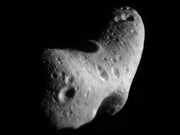Planetary Trio Provides a Warm-Up Act for Perseids
Thursday, August 12th, 2010

Are you eager to see the annual Perseids meteor shower tonight? You’ll have to wait until near midnight to see it, so why not pass the time by viewing Venus, Saturn and Mars right from your doorstep? Step outside for the planetary warm-up act just as soon as the sun sets. (Viewing times will be best over the next week. By August 20, the planets set lower on the horizon and are harder to see.)
All you have to do is look towards the west for bright Venus to appear. Now hold your clenched fist up to the sky, covering Venus. To the right of Venus, about half of a clenched fist away, is a second planet: That’s Saturn! And to the upper left of Venus is another planet: Mars!
That’s not all you’ll be able to see. Look below Venus for the slender crescent moon. If you don’t see the moon, look again on the night of Friday, August 13 — it will be a larger crescent to the left of Venus.
Though the three planets appear together in our line of sight, they are really far apart from each other. Mars is about 300 million kilometers (about 185 million miles) from Earth, while Venus is 112 million kilometers (about 70 million miles) away. Saturn? It’s 1,535 million kilometers (about 954 million miles) from Earth. And finally, the moon is only 363 thousand kilometers (about 225 thousand miles) away. It’s fun to compare the size of the moon and Mars, especially if you received that annual email incorrectly stating that Mars will be as big as the moon this month.






















